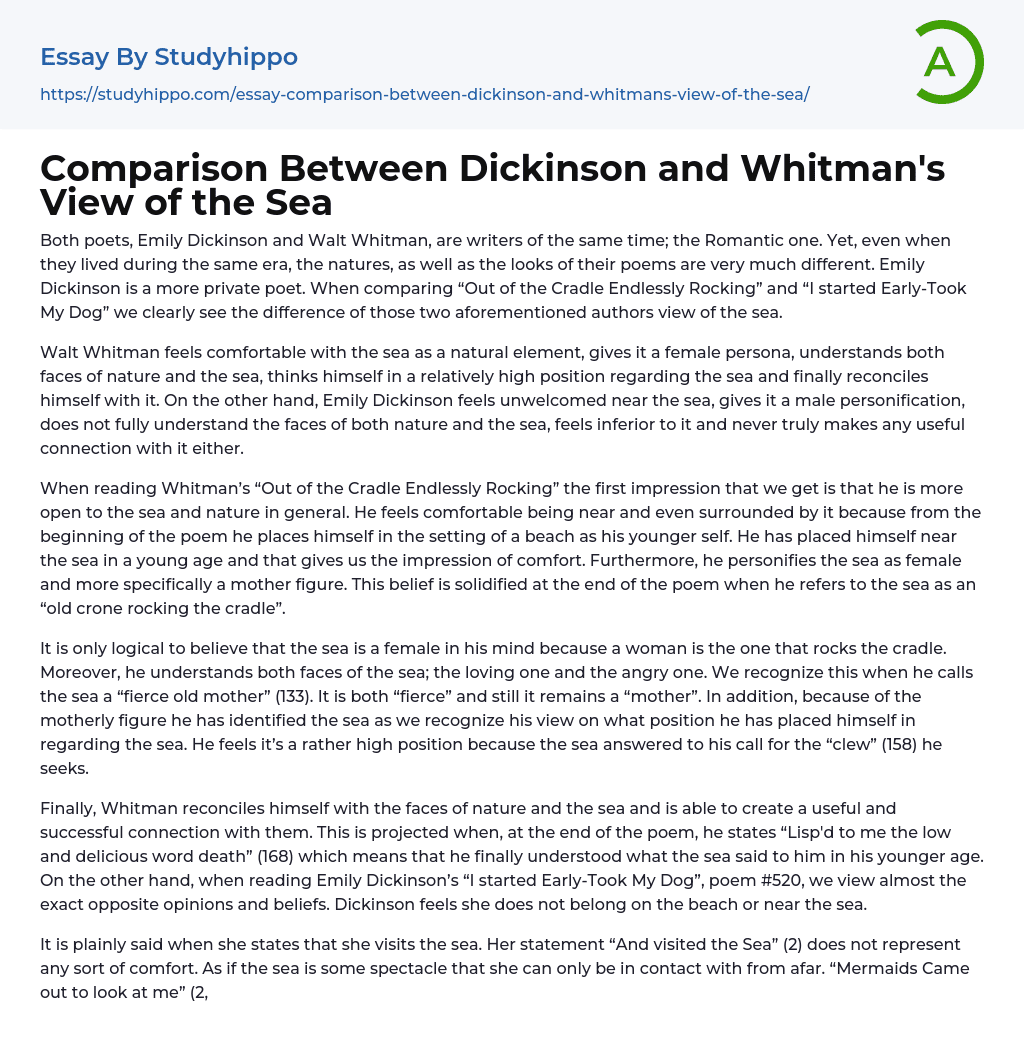

Comparison Between Dickinson and Whitman’s View of the Sea Essay Example
Both poets, Emily Dickinson and Walt Whitman, are writers of the same time; the Romantic one. Yet, even when they lived during the same era, the natures, as well as the looks of their poems are very much different. Emily Dickinson is a more private poet. When comparing “Out of the Cradle Endlessly Rocking” and “I started Early-Took My Dog” we clearly see the difference of those two aforementioned authors view of the sea.
Walt Whitman feels comfortable with the sea as a natural element, gives it a female persona, understands both faces of nature and the sea, thinks himself in a relatively high position regarding the sea and finally reconciles himself with it. On the other hand, Emily Dickinson feels unwelcomed near the sea, gives it a male personificatio
...n, does not fully understand the faces of both nature and the sea, feels inferior to it and never truly makes any useful connection with it either.
When reading Whitman’s “Out of the Cradle Endlessly Rocking” the first impression that we get is that he is more open to the sea and nature in general. He feels comfortable being near and even surrounded by it because from the beginning of the poem he places himself in the setting of a beach as his younger self. He has placed himself near the sea in a young age and that gives us the impression of comfort. Furthermore, he personifies the sea as female and more specifically a mother figure. This belief is solidified at the end of the poem when he refers to the sea as an “old crone rocking the cradle”.
I
is only logical to believe that the sea is a female in his mind because a woman is the one that rocks the cradle. Moreover, he understands both faces of the sea; the loving one and the angry one. We recognize this when he calls the sea a “fierce old mother” (133). It is both “fierce” and still it remains a “mother”. In addition, because of the motherly figure he has identified the sea as we recognize his view on what position he has placed himself in regarding the sea. He feels it’s a rather high position because the sea answered to his call for the “clew” (158) he seeks.
Finally, Whitman reconciles himself with the faces of nature and the sea and is able to create a useful and successful connection with them. This is projected when, at the end of the poem, he states “Lisp'd to me the low and delicious word death” (168) which means that he finally understood what the sea said to him in his younger age. On the other hand, when reading Emily Dickinson’s “I started Early-Took My Dog”, poem #520, we view almost the exact opposite opinions and beliefs. Dickinson feels she does not belong on the beach or near the sea.
It is plainly said when she states that she visits the sea. Her statement “And visited the Sea” (2) does not represent any sort of comfort. As if the sea is some spectacle that she can only be in contact with from afar. “Mermaids Came out to look at me” (2,3) promotes alienation as well. It’s as if the inhabitants of the sea view
her as an outsider and are monitoring her every move. Another reason she feels more isolated from the sea is because she has personified it with the male gender with which she does not have any real experience and so she does not know how to handle it.
Moreover, she does not fully understand both faces of nature, and thus the sea. “And made as he would eat me up” (13) is a phrase that shows us how focused she is on the aggressive side of the sea. Because she was so focused on the angry side of the sea, even before it tried to take her, she feels greatly inferior to it. She states “Presuming Me to be a Mouse”. This phrase is what shows us her feelings of inferiority because she feels as defenseless against the sea as a mouse.
Because of this inferiority she feels towards the sea, she is not able to communicate with it, like Whitman did, and is unsuccessful into forming a useful connection with it. She forms a connection of fear and apprehensiveness when she is frightened to the extreme and runs away. On the whole, even if there are slight similarities in what is mentioned in the two poems, the differences mentioned above cannot be ignored. Dickinson’s view of the sea is one of fear and apprehension while Whitman’s view of it is one of mutual understanding.
- Book Summary essays
- Metaphor essays
- Reader essays
- Rhyme essays
- Literary devices essays
- Villain essays
- Books essays
- Genre essays
- Literary Criticism essays
- Writer essays
- Protagonist essays
- Simile essays
- Poem essays
- Book Report essays
- Book Review essays
- Greek Mythology essays
- Plot essays
- Tragic Hero essays
- Coming of Age essays
- Play essays
- Rhetoric essays
- Rhetorical Question essays
- Translation essays
- Understanding essays
- Reason essays
- Character essays
- Letter essays
- American Literature essays
- Literature Review essays
- Utopia essays
- Poetry Analysis essays
- Dante's Inferno essays
- Between The World and Me essays
- Incidents in The Life of a Slave Girl essays
- Flowers for Algernon essays
- Myth essays
- Everyday Use essays
- Boo Radley essays
- Genesis essays
- Richard iii essays
- Alice in Wonderland essays
- On the road essays
- Ozymandias essays
- The Nightingale essays
- Holden Caulfield essays
- Animal Farm essays
- 1984 essays
- A Hanging essays
- Shooting An Elephant essays
- A Tale Of Two Cities essays



